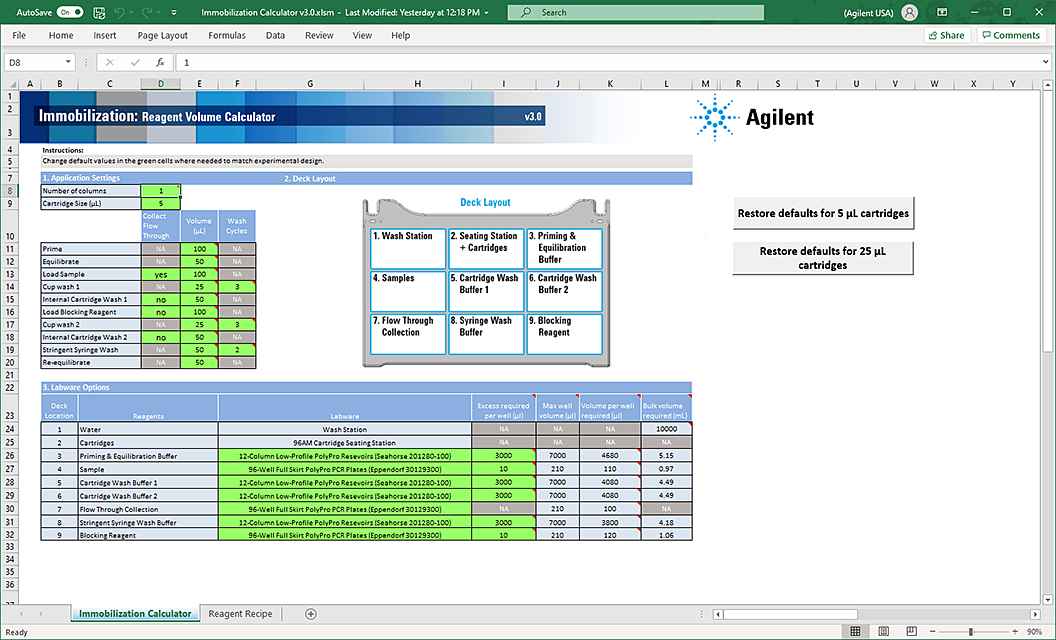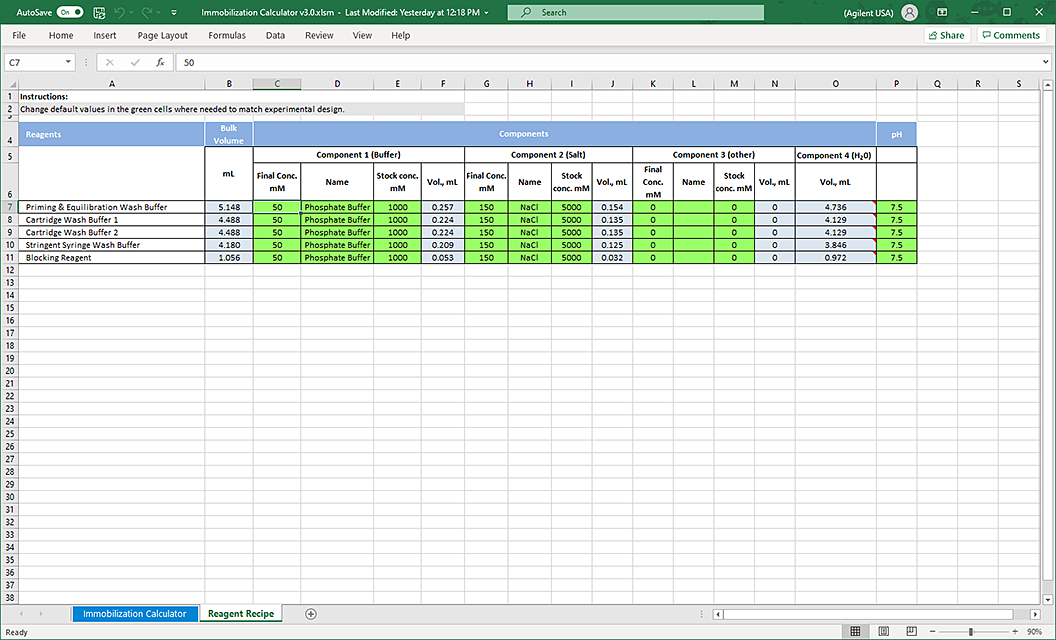Preparing the solutions

The following solutions are used for the Immobilization protocol:
• Priming & Equilibration Buffer
• Wash Buffers: Cartridge Wash 1, Cartridge Wash 2, and Stringent Syringe Wash
• Blocking Reagent
Note: You can find the Labware Reference Guide in the Literature Library page of the Protein Sample Prep Workbench.
Using the Immobilization Reagent Volume Calculator
The Reagent Volume Calculator is a Microsoft Excel file that contains the following:
• Calculator worksheet. You enter the number of columns to process, whether to perform the Collect Flow Through option, the volume for each step in the protocol, the number of wash cycles to conduct, and the labware selection for each deck location. The calculator determines the volumes required based on your input, taking into consideration pipetting overage and evaporation concerns.
Note: The pipetting overage suggested is generally conservative. The minimal overage may be greater or less depending on the volatility of the solution, the length of the run, and when the step occurs during the run. The overage volume can be optimized to minimize loss of precious reagents.
• Reagent Recipe worksheet. You enter the concentrations of each component in your reagent, and the worksheet calculates the recipe volumes required.
To use the Reagent Volume Calculator:
1 Open the App Library.
2 Locate the application, and then click the corresponding Calculator button. Microsoft Excel starts and displays the calculator.
3 Ensure that you enable content in Microsoft Excel.
4 Click one of the following:
• Set defaults for 5µL cartridges. Sets the values in the calculator using the values from the default method for the 5 µL cartridges.
• Set defaults for 25µL cartridges. Sets the values in the calculator using the values from the default method for the 25 µL cartridges.
5 Modify the values in the green boxes as required to match your specific method. As you change the values in the green boxes, the calculated values change.
Note: The green box should remain green after you enter a value. If you enter a value that is outside the normal working range, the box becomes yellow. If you enter a value that is outside of the acceptable range, the box becomes red.
To display the corresponding tooltip for a setting, mouse over a box that has a red triangle in the upper right corner.
The following figures show the worksheets of the Reagent Volume Calculator.
Figure Immobilization Reagent Volume Calculator worksheet
 |
Figure Immobilization Reagent Recipe worksheet
 |
Preparing the buffers
The following table describes the reagents and deck locations. The AssayMAP protocols are blind to the composition of the solutions, so you can easily adapt your optimized chemistry. Agilent recommends the following buffers as a starting point for optimizing the AssayMAP immobilization chemistry.
Table Reagent preparation
Reagent (deck location) | Composition and comments |
|---|---|
Priming & Equilibration Buffer (deck location 3) | Typically a buffered aqueous solution with neutral pH and physiologic salt concentration, for example, Phosphate-Buffered Saline (PBS), similar in composition to the buffer solution used to prepare the sample. Note: The Immobilization application also uses this buffer to wash the cartridges during the re‑equilibration step. |
Cartridge Wash Buffer 1 (deck location 5) | A high-stringency buffer (for example, a neutral buffer with high NaCl) or a low-stringency buffer (for example, PBS). The Immobilization application allows the use of one or two wash solutions. The buffer selection depends on a number of factors. First, consider whether a blocking agent will be used. If so, one would typically use the low stringency solution for Cartridge Wash Buffer 1 and a high stringency wash buffer for Cartridge Wash Buffer 2, which would remove the loosely bound affinity ligand and blocking reagent from the resin bed. If a blocking reagent is not used, you would typically use a high-stringency wash buffer, such as PBS with high salt for Cartridge Wash 1 and use a low-stringency wash for Cartridge Wash Buffer 2. |
Cartridge Wash Buffer 2 (deck location 6) | A high-stringency buffer (for example, a neutral buffer with high NaCl) or a low-stringency buffer (for example, PBS). The composition of this buffer is often dictated by the composition of Cartridge Wash Buffer 1. Cartridge Wash Buffer 2 will be replaced by the Priming & Equilibration Buffer if the Re-Equilibrate step is selected. |
Stringent Wash Buffer (deck location 8) | The composition can vary widely depending on the experiment. Typically, this buffer would match the composition of the elution buffer that will be used during the Affinity Purification run, which usually follows the Immobilization run. |
Blocking Reagent (deck location 9) | This reagent is most commonly used with SA-W cartridges in which case a free biotin solution is used to bind to the unbound streptavidin molecules on the surface of the resin. This blocks the streptavidin molecules that are not bound to the affinity ligand from binding to molecules present in the sample loaded on the cartridges during a subsequent Affinity Purification run using these cartridges. |
Dispensing the solutions
To dispense the solutions into the labware:
1 Optional. Label the labware so that you can easily identify them.
2 Add the specified volume of Priming & Equilibration Buffer into the labware to be placed at deck location 3.
3 Add the specified volume of Cartridge Wash Buffer 1 into the labware to be placed at deck location 5.
4 If using two wash buffers, add the specified volume of Cartridge Wash Buffer 2 into the labware to be placed at deck location 6.
5 Add the specified volume of Stringent Wash Buffer into the labware to be placed at deck location 8.
6 Add the specified volume of Blocking Reagent into the labware to be placed at deck location 9.
7 If necessary, centrifuge the reagent labware to remove bubbles.
Note: You can use the Reagent Aliquot utility to dispense the buffers. For details, see Reagent Aliquot v2.0 User Guide.